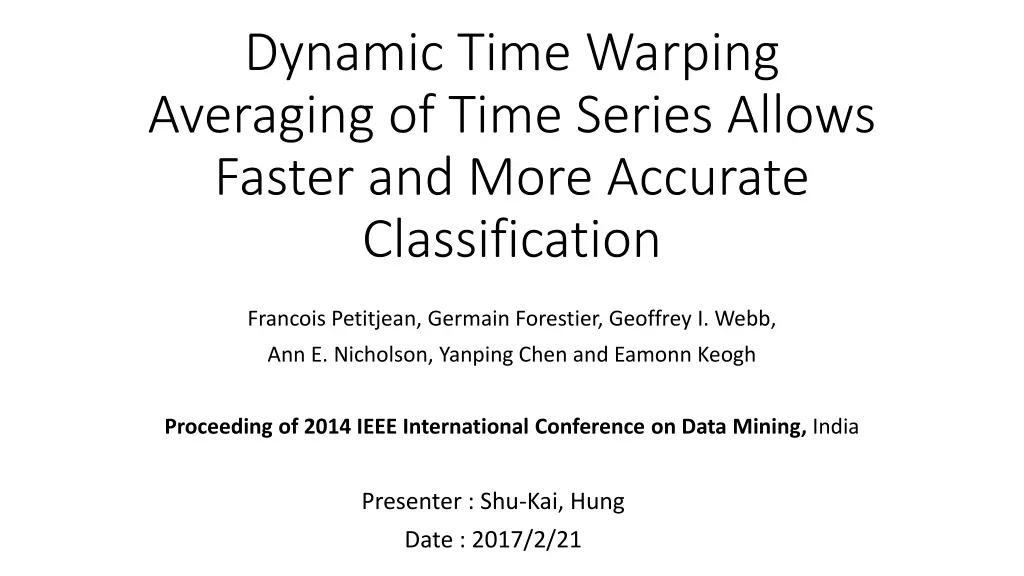
Dynamic Time Warping Averaging: Ultra-Efficient Classification Method
Explore the innovative technique of Dynamic Time Warping Averaging for faster and more accurate time series classification. Learn how this method offers efficient solutions, particularly beneficial for resource-constrained devices and wearable technologies. Discover how the technique allows for meaningful averaging of warped time series, leading to ultra-efficient Nearest Centroid classifiers.
Download Presentation

Please find below an Image/Link to download the presentation.
The content on the website is provided AS IS for your information and personal use only. It may not be sold, licensed, or shared on other websites without obtaining consent from the author. If you encounter any issues during the download, it is possible that the publisher has removed the file from their server.
You are allowed to download the files provided on this website for personal or commercial use, subject to the condition that they are used lawfully. All files are the property of their respective owners.
The content on the website is provided AS IS for your information and personal use only. It may not be sold, licensed, or shared on other websites without obtaining consent from the author.
E N D
Presentation Transcript
Dynamic Time Warping Averaging of Time Series Allows Faster and More Accurate Classification Francois Petitjean, Germain Forestier, Geoffrey I. Webb, Ann E. Nicholson, Yanping Chen and Eamonn Keogh Proceeding of 2014 IEEE International Conference on Data Mining, India Presenter : Shu-Kai, Hung Date : 2017/2/21
Abstract(1/2) Abstract(1/2) Recent years have seen significant progress in improving both the efficiency and effectiveness of time series classification. However, because the best solution is typically the Nearest Neighbor algorithm with the relatively expensive Dynamic Time Warping as the distance measure, successful deployments on resource constrained devices remain elusive. Moreover, the recent explosion of interest in wearable devices, which typically have limited computational resources, has created a growing need for very efficient classification algorithms.
Abstract(2/2) Abstract(2/2) A commonly used technique to glean the benefits of the Nearest Neighbor algorithm, without inheriting its undesirable time complexity, is to use the Nearest Centroid algorithm. However, because of the unique properties of (most) time series data, the centroid typically does not resemble any of the instances, an unintuitive and underappreciated fact. In this work we show that we can exploit a recent result to allow meaningful averaging of warped times series, and that this result allows us to create ultra-efficient Nearest Centroid classifiers that are at least as accurate as their more lethargic Nearest Neighbor cousins.
Definition 1: Time Series. A time series ? = (?1,?2, .,??)is an ordered set of real values. The total number of real values is equal to the length of the time series (L). A dataset ? = {?1,?2, ,??}is a collection of such time series. Definition 2: Average object. Given a set of objects ? = ?1,?2, .,??in a space ? induced by a measure d, the average object ? is the object that minimizes the sum of the squares to the set:
DTW Barycenter Averaging (DBA) Compute multiple series averaging with DTW
? = ??(,D2) ?1= 1,3,4,5 ?2= 2,1,3,2 ?3= (1,4,3,1) Alignment2 = { , , , } Alignment3 = { , , ,{3}} 1 3 4 3 2 1 1 4 1 1 0 4 9 4 3 4 0 1 1 2 1 1 4 1
? = ?? ?1= 1,3,4,5 ?2= 2,1,3,2 ?3= (1,4,3,1) Alignment2 = { , , , } Alignment3 = { , , {4},{3}} 1 3 4 3 2 1 1 4 1 1 0 4 9 4 3 4 0 1 1 2 1 1 4 1
? = ?? ?1= 1,3,4,5 ?2= 2,1,3,2 ?3= (1,4,3,1) Alignment2 = { , , , } Alignment3 = { , , {3,4},{3}} 1 3 4 3 2 1 1 4 1 1 0 4 9 4 3 4 0 1 1 2 1 1 4 1
? = ?? ?1= 1,3,4,5 ?2= 2,1,3,2 ?3= (1,4,3,1) Alignment2 = { , , , } Alignment3 = { ,{1}, {3,4},{3}} 1 3 4 3 2 1 1 4 1 1 0 4 9 4 3 4 0 1 1 2 1 1 4 1
? = ?? ?1= 1,3,4,5 ?2= 2,1,3,2 ?3= (1,4,3,1) Alignment2 = { , , , } Alignment3 = {{1},{1}, {3,4},{3}} 1 3 4 3 2 1 1 4 1 1 0 4 9 4 3 4 0 1 1 3 Alignment3 2 1 1 4 1 Alignment3.2(?2, ?2) = {{2},{1},{3},{2}} Alignment3.3(?2, ?3)={{1},{1},{3,4},{1}}
Alignment2 =Alignment3 Alignment3.2 Alignment3.3 Alignment2 = {{1,2},{1},{3,4},{1,2,3}} ? = {{1.5},{1},{3.5},{2}}
Reduce Reducing the data cardinality Reducing the data dimensionality Reducing the number of objects the nearest neighbor algorithm(DBA)
Experiment Data Drop{X} : numerosity reduction Simple Rank (SR) : using leave-one-out 1-NNclassification k-medoids ( ) K-Means( )
